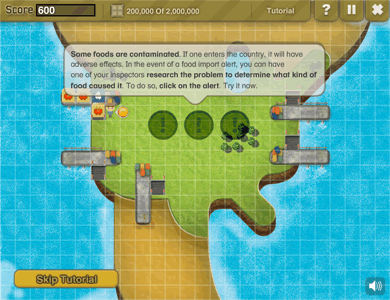As I mentioned in my last post, as the world becomes more complex, our need to understand it through new media that can convey complexity grows. I was excited to learn that the New York Times is now publishing Persuasive Games‘ “newsgames” — a casual game about the FDA’s role in food inspections. This historic arrangement puts games smack on the editorial pages of the nation’s paper of record*… an amazing coup for Ian Bogost’s crew at Georgia Tech.
The game itself is relatively simple: the idea is to use your two food inspectors to inspect incoming shipments or to research the origins of food contamination. Each activity takes a certain amount of time. The purpose of inspecting a container is to interdict contaminated food:

If contaminated food slips through, researching the contamination can identify what food caused the contamination. This suggests that the next few batches of that same food are likely to also be contaminated.

There are five different types of food. Clearing each year (level) requires the player to deploy the two inspectors intelligently, inspecting different food types and then concentrating on contaminated food until they become safe again. (Then another food type will get contaminated). The strategy is very simple, and the pace of the game accelerates significantly at each year/level.
As a game “Food Import Folly” provides maybe 10-15 minutes of entertainment. It also, as its name suggests, offers a critique of the current funding and staffing of FDA inspection services. As the opening screen describes, the amount of food that the FDA inspects has gone from 2 to 9 million shipments since 1997 to today, yet the FDA’s budget remains essentially the same.
“Food Import Folly” is a great marriage of traditional and interactive advocacy media. My wish for the genre — besides expansion — is that they add more nuance and sophistication to the editorial pages. Nowadays, good editorial cartoons distill difficult issues and feelings into a pithy and “truthy” image. By contrast, the power of interactive media is to emphasize complexity, systems, and decision-making. FIF touches on strategic decision-making, but its core mechanic turns, ultimately, on twitch reflexes. Still, its madcap quality — not unlike Lucy’s chocolate factory — makes the point nicely. I’m eager to see what directions Persuasive Media will take its games in the coming months.
* Times Select required — now free to anyone with a .edu email address.







{ 2 } Trackbacks
[…] Thompson took the opposite tack by starting with “grassroots” (what some might consider “lowbrow”) games — games he compared with graffiti, raw responses to a raw world. Critiquing designers’ apparent preference for sim games — and specifically taking aim at SimCity for setting the bar for all G4C ever since — Thompson suggested that quick, dirty, to-the-gut games are what’s needed. Rather, he held up WTC Defender (can’t seem to find it, but here’s an article about its removal) as an ideal type of this genre. It’s a provocative point, but I don’t buy that WTC Defender is a game for change, nor that it’s a good model for the G4C movement to build off. It’s readable as a G4C only using Thompson’s interpretation: that, because the player is bound to lose eventually, it’s critiquing the notion that we can defend ourselves through military might. Perhaps that’s true if you can frame the game properly (Food Import Folly uses the manic quality of classic games to make a similar point), but the point is a relatively naive one. […]
[…] game was less a simulation and more an exercise in futility, much like the message embedded in Ian Bogost’s “editorial games” for the New York […]